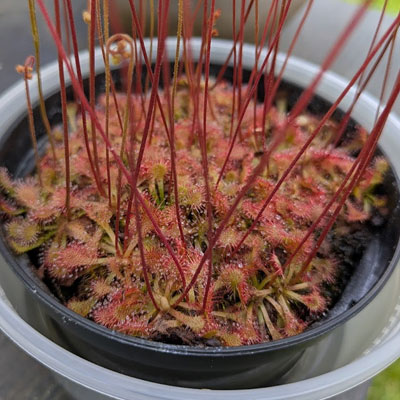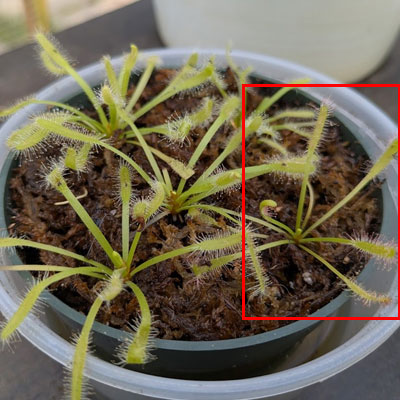Furry Migration 2025 - How To Grow Carnivorous Plants
Thank you for coming to my panel at Furry Migration 2025 and (hopefully) taking a plant home with you! Here is some info and links that will should help you take care of your plant and dive deeper into growing carnivorous plants, if you so choose. I made this webpage the Monday before the convention, so I apologize if it does not display the greatest. If you have any questions or want to show me your plants' growth, reach out to me on Bluesky (most active) or tumblr! You can view the presentation slides and my notes here as well.
ID Your Plant
The grow cell that you received at the con may contain one or both of the following species: Drosera spatulata, the spoon-leaved sundew, or Drosera capensis 'Alba' (also known as 'Albino'), the cape sundew (white variety). Telling the difference when the seedlings are very young/small may be difficult. The main difference is that Drosera capensis 'Alba' has an oblong leaf, while Drosera spatulata has shorter, rounder leaves (really suits the name of 'spoon-leaved'). They will both grow and thrive in similar conditions, so the care should be the same for both species.
Drosera spatulata (left image shown below) will exhibit some red coloration on their tendrils when they get enough sunlight. Drosera capensis 'Alba' (right image shown below) is a cultivar that keeps the tendrils very pale. It may show some pink-ish coloration when getting enough sunlight (example marked in red). By the way, the two pots pictured below are the parents of your sundews!


Care Guide
These sundews are sub-tropical and will do best in temperatures 60 degrees Farenheit and above. Ideally grow them outside all year round if possible, otherwise seasonally giving them time outdoors will do. They like full sun; light is important for their dew production. If you are staying in the Furry Migration hotel, I recommend putting them in the windowsill but covering them with another plastic cup or something similar to prevent the hotel air conditioning from drying them out. Make sure not to forget them in the windowsill when you check out!
Keep them in about 1/2 inch to 1 inch of low PPM water. Sundews like 50 PPM or less. The tray method will work great for sundews. You can keep them in the cup that they came in, but you may want to move them into something shallower so that they can get some airflow and better sun. If you ever upgrade them to a larger pot, then you basically don't want the water to be kept deeper than half the height of the pot. This may require dumping some water out if it heavily rains. If you have to water your sundews with more than 50 PPM water, make sure to rinse the soil by watering from the top and letting the water drain away the next time that you can obtain low PPM water.
Eventually your sundews will grow up to be bigger, but they certainly are not gigantic plants. If they are catching their own meals or getting fed, this often speeds up their growth. You may want to repot them into a slightly larger pot, a 4 inch round pot should be plenty. I'm going to just link a guide to repotting sundews for the nitty gritty details and there are plenty of YouTube videos out there. Premade soil mixes that you can purchase will be linked in the last section on this page.
If your sundew flowers, you can choose to cut the flower stalks or let them bloom. Sundews will pollinate themselves, so if you let them bloom, the stalk should produce seeds once it has dried up. Those seeds can fall into the soil of your pot and produce lots of new sundews! You can also harvest the seeds and plant them in another container, much like I did to prepare these sundews for the convention.
Sundews with enough light should be able to fend for themselves when it comes to trapping prey. If you find a small insect in your home, you can totally put it on your sundew and watch it get globbed by the mucilage. If you want to feed them with fish food or other methods, here's a link.
Tool Links
Note: I am not a cool person that receives monetization or anything from recommending these links. I personally don't order from Amazon as much as possible these days, but may suggest Amazon listings. If you want to buy from Amazon that's up to you, or you can at least see what the product is and then shop around at other places.
- TDS meter - $10 | Not the exact one that I purchased back in 2020, but should do the trick.
- ZeroWater Pitcher - $37.99 | If you don't want to buy distilled water jugs at the store, this is the only way other than having a reverse osmosis system or being completely reliant on rain water. This pitcher comes with a TDS meter, so you don't have to buy one separately.
- ZeroWater replacement filters - $17.99/1 filter | Bulk discounts don't come into effect until you're buying a 3 pack or more.
- 6" Succulent/Bonsai tweezers with angled tips - $6.50 | Not the exact listing I bought from in 2019, anything similar will do. I use these to pull dead plant material away and to feed insects to my plants on occasion. Also useful when repotting.
- Herb/Bonsai scissors - $14.50 | Definitely not what I bought in 2019, but should do the trick. Useful to snip away dead plant material in tandem with the tweezers above.
- Mosquito Bits 8oz - 16.99 | I've never needed to do mosquito treatment, but if you have issues...
- Maxsea All Purpose - $22.24 | If you want to try fertilizing your Nepenthes. Highly recommend reading up on how to do this, but I usually read that people mix it at 1/4 strength.
- Osmocote Pellets - $7.39 | Also if you want to try fertilizing your Nepenthes. Also highly recommend reading up on how to do this.
Recommended Reading Sites
As I mentioned during the panel, I learned most of what I know about carnivorous plants just from reading various websites about the different types and care methods. Here's a list of places that I like to check and read up from.
- International Carnivorous Plants Society - Huge information trove that also has growing information
- Sarracenia.com FAQ - Lots of information, includes some really neat photo field trips to wild populations
- Grow Sundews - A sundew-specific site
- /r/SavageGarden, the carnivorous plant subreddit - I don't use reddit anymore but useful resources and community
- Carnivorous plant on Wikipedia - Go, begin your carnivorous plant Wikipedia rabbithole journey
- Curious Plant Resources - A variety of different articles on care
Growing Medium Listings
Here are some growing medium listings for various carnivorous plant soil mixes. I have only purchased from Curious Plant myself. I do not have first-hand experience with other sellers, however they are often recommended across other sites. I assume that most people will not get so deep into the hobby that they buy a bale of peat moss and a bag of perlite to mix their own growing medium like myself. Nevermind the fact that both have only been maybe 1/8 used and I bought them more than 4 years ago...
- Curious Plant Carnivorous Plant Soil Mix - $7 for 2 cups | For Venus flytraps, Drosera, and Sarracenia. This is the listing that I have purchased before myself.
- California Carnivores Peat and Perlite Mix - $13.99 for 1 gallon | For Venus flytraps, Drosera, and Sarracenia.
- California Carnivores Premium Nepenthes mix - $24.99 for 1 gallon | For Nepenthes.
- Sarracenia Northwest General Soil Mix - $9.95 for 1 gallon | For Venus flytraps, Drosera, and Sarracenia.
- Sarracenia Northwest Tropical Pitcher Plant Mix - $11.95 for 1 gallon | For Nepenthes